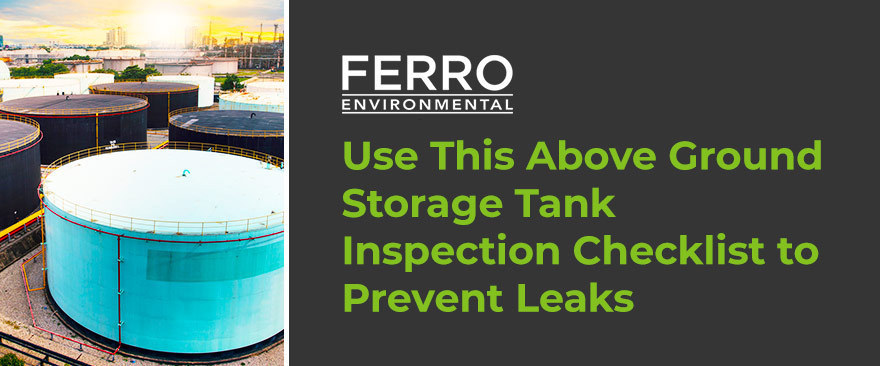
It’s important to carry out timely inspections of your above ground storage tank. Not only does it help prevent leaks, which can contaminate surroundings and force you into costly repair work, but also guarantee that you are following all storage tank regulations and codes, such as the Canadian Environmental Protection Act, Storage Tank Systems for Petroleum Products and Allied Petroleum Products Regulations, National Fire Code of Canada and others.
The Canadian federal government requires that a proper above ground storage tank inspection to look for corrosion, inspect the coating, test for leaks in the floor and floating roofs and examine the valves, piping, secondary containment and gauges for overfill protection. If done correctly, your inspection will result in lots of relevant information, which will provide you with a strong understanding of your above ground storage tank’s condition.
Above Ground Storage Tank Inspection Checklist
This checklist will give you an idea of what to expect from a properly completed above ground storage tank inspection. Canadian regulations require that the inspection be thorough to ensure that all risks to leaks – which can cause environmental and/or property damage and even harm people – are identified and resolved through repair or if need be, removal.
1. Containment
The inspector should examine if the condition of the containment structure complies with regulations. This process includes inspecting the drainage pipes and valves. If your tank is without secondary containment, then it’s visually inspected once per month.
2. Foundation/Supports
The inspector will look assess the integrity of the foundation. This includes identifying if there is cracking or spalling of the concrete pad and/or wing wall. Are the structures supporting the tank in acceptable condition and is the grounding strap still secure?
3. External Coating
It is crucial that the tank’s coating withstands the effects of weather and direct sunlight. If the tank’s external coating is deprecating and losing its effectiveness, then you will be at risk of a leak.
4. Shell/Heads
The inspector will see if the storage tank shell and head are free of defects, such as bulging, cracks and corrosion.
5. Manways, Piping, and Equipment with Secondary Containment
A secondary containment helps with protecting you from a leak, but the inspector must ensure that the bolts connecting the tank to the secondary containment are tight and free of corrosion.
6. Roof
The inspector will check to see if there is standing water atop of the tank roof. Since it is part of the exterior, the inspector will also look for cracks, holes and other flaws.
7. Vents
You must ensure that the vents are not obstructed. In addition, the emergency vent and lift of your tank must function correctly.
8. Insulated Tanks
The tank must have sufficient insulation, which includes insulation integrity to protect against leaks. The inspector will look for moisture, mold, damage and potential signs of damage in your insulation.
9. Level and Overfill Prevention
The inspection will see if your tank’s fuel gauge and overfill prevention equipment are working correctly. In double-walled tanks, the inspector will check to see if the interstitial monitor (for seeing between the two walls) is also in proper working condition. These systems are tested using your tank manufacturer’s instructions.
10. Electrical Equipment
You must ensure that the tank’s electrical equipment, including the control boxes and grounding lines, are also in satisfactory condition.
11. Internal Product Quality
Finally, the inspector will check to see the condition of your storage tank’s content, be it fuel or another substance. This is done to ensure that there is no bacterial contamination, which will require treatment. In case of chemical content, the tank must be free of signs of possible damage or erosion.
There are many parts to this above ground storage inspection checklist, so the task requires an experienced and competent inspector. Otherwise, you could miss important observations about your storage tank, which would put you at risk of leaks and losses from damage. If your storage tank has structural problems, such as early signs of cracks, then you will know of it well before an accident can occur. Likewise, a competent inspector will also give you an idea of how much life is left in your tank by measuring the thickness of the shell and bottom plates.
Soil contamination is serious hazzard to humans and the environement
Speak to an environmental contractor immediately
1 (855) 551-7760
Following your inspection, you can have your above ground storage tank safely and legally by a certified environmental contractor. Are you looking for an expert to properly inspect & remove your storage tank? Contact us to schedule an appointment with our certified experts to discuss our enrionmental remediation services.

